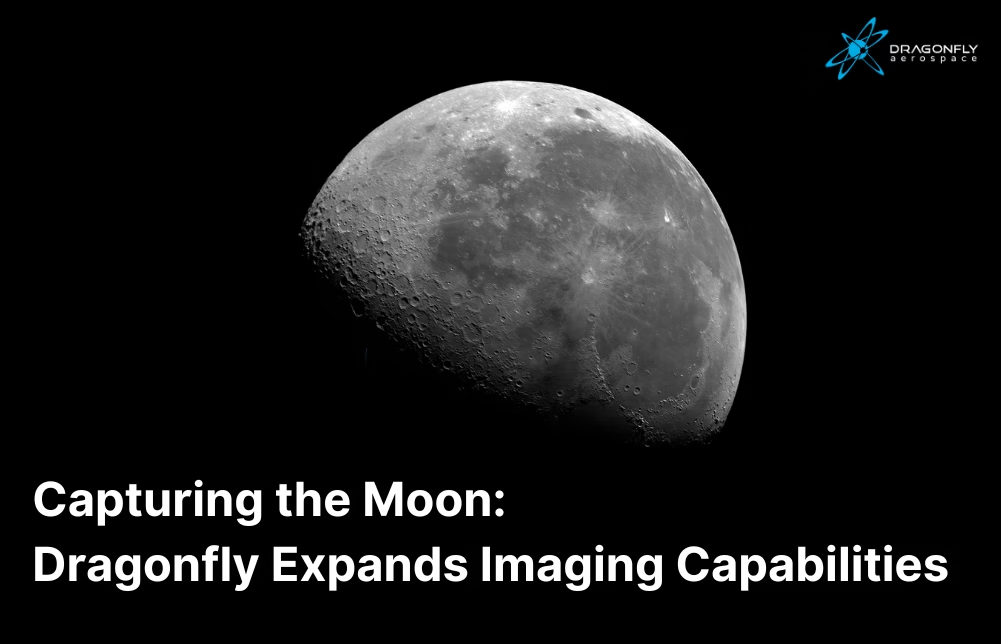
Dragonfly Aerospace has successfully demonstrated a significant new capability: capturing high-precision images of the Moon using the dual DragonEye imagers aboard its EOSSAT-1 satellite. This achievement represents a key milestone in the company’s ongoing efforts to extend its imaging technologies beyond traditional Earth observation, marking its expansion into Non-Earth Imaging(NEI).
The Non-Earth Imaging Technqiue
Unlike most small satellite missions that prioritise Earth observation, Non-Earth Imaging (NEI) involves capturing imagery of celestial bodies and objects beyond our planet, such as the Moon, planets, asteroids, space debris, and other astronomical reference points. NEI plays a critical role in validating imaging systems under deep-space conditions. It also contributes to Space Situational Awareness (SSA) and supports future lunar and planetary exploration efforts. In essence, NEI serves as a bridge between conventional Earth observation and deep-space missions, broadening our capacity to observe, understand, and navigate the wider universe.
EOSSAT-1: Precision Non-Earth Imaging in Orbit
To capture images of both a full Moon and a waning Moon, Dragonfly Aerospace utilised the ductile mode of its EOSSAT-1 satellite, a function typically reserved for tracking inertial reference points. Given that the DragonEye payloads are line-scan imagers, the satellite had to perform a continuous pitch manoeuvre across the lunar surface, building each image line by line rather than capturing it in a single frame. This placed stringent requirements on EOSSAT-1’s Attitude and Orbit Control System (AOCS), which needed to maintain a precise and stable pitch rate throughout the imaging sequence.
Despite the Moon’s relatively slow apparent motion, the satellite was required to execute continuous, high-accuracy pitch adjustments to track its trajectory and preserve exact line-of-sight alignment. EOSSAT-1 successfully imaged multiple lunar phases, demonstrating its ability to maintain stable attitude control on inertial targets, a capability that exceeds the performance typically expected from standard small satellite platforms.
Versatile Imaging for Complex Space Missions
Dragonfly Aerospace develops platforms designed for multi-purpose imaging missions. Although the company’s core expertise lies in high-performance Earth observation, the μDragonfly bus and other satellite platforms offer engineered flexibility, making them capable of:
- Monitoring space assets and tracking debris
- Calibrating onboard sensors using inertial points
- Supporting lunar and planetary exploration
- Validating satellite stability and control systems
The recent lunar imaging demonstration highlights both the increasing importance of NEI and SSA in commercial satellite operations and the advanced capabilities built into Dragonfly’s platforms. Furthermore, this success reflects the company’s commitment to meeting emerging demands in space technology.
Why These Capabilities Matter
As the space environment grows increasingly congested and operationally complex, the demand for robust Space Situational Awareness (SSA) and Space Domain Awareness (SDA) continues to rise. Imaging objects beyond Earth, such as the Moon, satellites, and orbital debris plays a vital role in advancing these capabilities. Such imaging supports collision avoidance and orbital traffic management, facilitates sensor calibration and technology validation, and informs mission planning for future lunar and planetary exploration.
Dragonfly Aerospace remains committed to providing flexible, high-performance satellite solutions that go beyond Earth observation. Both the μDragonfly platform and Dragonfly’s custom payloads are designed to support:
- Earth Observation (EO)
- Non-Earth Imaging (NEI)
- Space Situational Awareness (SSA)
- Scientific and exploratory missions
Looking Beyond Earth
As satellite operations continue to evolve, the ability to capture and process data beyond Earth is becoming increasingly valuable not only for advancing space exploration, but also for enhancing safety, security, and long-term sustainability in orbit. Dragonfly Aerospace’s successful demonstration with EOSSAT-1 underscores the growing potential of small satellite platforms to take on more complex roles, particularly in space monitoring, technology validation, and Non-Earth Imaging. Collectively, these developments signal a shift beyond traditional Earth observation toward more versatile and mission-critical space applications.
